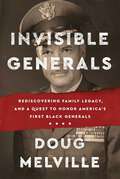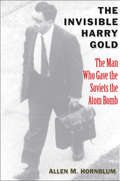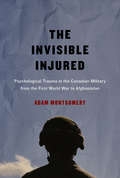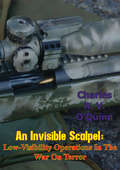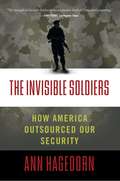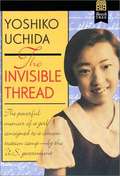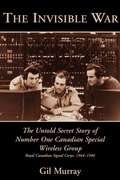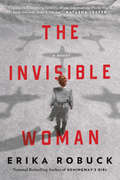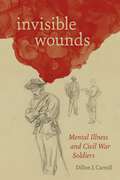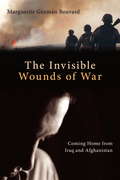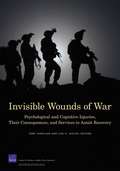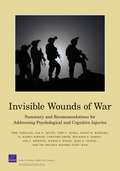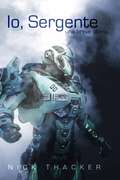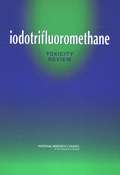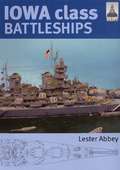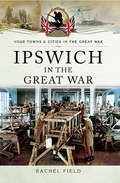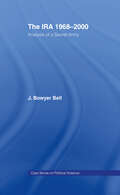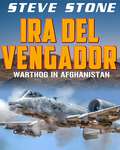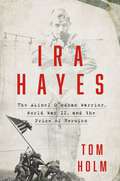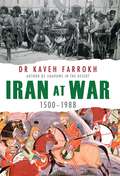- Table View
- List View
Invisible Generals: Rediscovering Family Legacy, and a Quest to Honor America's First Black Generals
by Doug MelvilleThis amazing true story of America&’s first Black generals, Benjamin O. Davis Sr. and Jr., a father and son who helped integrate the American military and created the Tuskegee Airmen, is &“the book Black America needs in this moment&” (Eboni K. Williams, lawyer and cohost of State of the Culture).Red Tails, George Lucas&’s celebration of America&’s first Black flying squadron, the Tuskegee Airmen, should have been a moment of victory for Doug Melville. He expected to see his great-uncle Benjamin O. Davis Jr.—the squadron&’s commander—immortalized on-screen for his selfless contributions to America. But as the film rolled, Doug was shocked when he realized that Ben Jr.&’s name had been omitted and replaced by the fictional Colonel A. J. Bullard. And Ben&’s father, Benjamin O. Davis Sr., America&’s first Black general who helped integrate the military, was left out completely. Dejected, Doug looked inward and realized that unless he worked to bring their inspirational story to light, it would remain hidden from the world just as it had been concealed from him. In this &“thoughtful, highly readable blend of family and military history&” (Kirkus Reviews), Melville shares his quest to rediscover his family&’s story across five generations, from post-Civil War America to modern day Asia and Europe. In life, the Davises were denied the recognition and compensation they&’d earned, but through his journey, Melville uncovers something greater: that dedication and self-sacrifice can move proverbial mountains—even in a world determined to make you invisible. Invisible Generals recounts the lives of a father and his son who always maintained their belief in the American dream. As the inheritor of their legacy, Melville retraces their steps, advocates for them to receive their long-overdue honors and unlocks the potential we all hold to retrieve powerful family stories lost to the past.
The Invisible Harry Gold
by Allen M. HornblumIn the history of Soviet espionage in America, few people figure more crucially than Harry Gold. A Russian Jewish immigrant who spied for the Soviets from 1935 until 1950, Gold was an accomplished industrial and military espionage agent. He was assigned to be physicist Klaus Fuchs's "handler" and ultimately conveyed sheaves of stolen information about the Manhattan Project from Los Alamos to Russian agents. He is literally the man who gave the USSR the plans for the atom bomb. The subject of the most intensive public manhunt in the history of the FBI, Gold was arrested in May 1950. His confession revealed scores of contacts, and his testimony in the trial of the Rosenbergs proved pivotal. Yet among his co-workers, fellow prisoners at Lewisburg Penitentiary, and even those in the FBI, Gold earned respect, admiration, and affection. InThe Invisible Harry Gold, journalist and historian Allen Hornblum paints a surprising portrait of this notorious yet unknown figure. Through interviews with many individuals who knew Gold and years of research into primary documents, Hornblum has produced a gripping account of how a fundamentally decent and well-intentioned man helped commit the greatest scientific theft of the twentieth century.
Invisible Injured: Psychological Trauma in the Canadian Military from the First World War to Afghanistan
by Adam MontgomeryCanadian soldiers returning home have always been changed by war and peacekeeping, frequently in harmful but unseen ways. The Invisible Injured explores the Canadian military’s continuous battle with psychological trauma from 1914 to 2014 to show that while public understanding and sympathy toward affected soldiers has increased, myths and stigmas have remained. Whether diagnosed with shell shock, battle exhaustion, or post-traumatic stress disorder, Canadian troops were at the mercy of a military culture that promoted stoic and manly behaviour while shunning weakness and vulnerability. Those who admitted to mental difficulties were often ostracized, released from the military, and denied a pension. Through interviews with veterans and close examination of accounts and records on the First World War, the Second World War, and post-Cold War peacekeeping missions, Adam Montgomery outlines the intimate links between the military, psychiatrists, politicians, and the Canadian public. He demonstrates that Canadians’ views of trauma developed alongside the nation’s changing role on the international stage – from warrior nation to peacekeeper. While Canadians took pride in their military’s accomplishments around the globe, soldiers who came back haunted by their experiences were often ignored. Utilizing a wide range of historical sources and a frank approach, The Invisible Injured is the first book-length history of trauma in the Canadian military over the past century. It is a timely and provocative study that points to past mistakes and outlines new ideas of courage and determination.
Invisible Injured: Psychological Trauma in the Canadian Military from the First World War to Afghanistan (McGill-Queen's/Associated Medical Services Studies in the History of Medicine, Health, and Society #46)
by Adam MontgomeryCanadian soldiers returning home have always been changed by war and peacekeeping, frequently in harmful but unseen ways. The Invisible Injured explores the Canadian military’s continuous battle with psychological trauma from 1914 to 2014 to show that while public understanding and sympathy toward affected soldiers has increased, myths and stigmas have remained. Whether diagnosed with shell shock, battle exhaustion, or post-traumatic stress disorder, Canadian troops were at the mercy of a military culture that promoted stoic and manly behaviour while shunning weakness and vulnerability. Those who admitted to mental difficulties were often ostracized, released from the military, and denied a pension. Through interviews with veterans and close examination of accounts and records on the First World War, the Second World War, and post-Cold War peacekeeping missions, Adam Montgomery outlines the intimate links between the military, psychiatrists, politicians, and the Canadian public. He demonstrates that Canadians’ views of trauma developed alongside the nation’s changing role on the international stage – from warrior nation to peacekeeper. While Canadians took pride in their military’s accomplishments around the globe, soldiers who came back haunted by their experiences were often ignored. Utilizing a wide range of historical sources and a frank approach, The Invisible Injured is the first book-length history of trauma in the Canadian military over the past century. It is a timely and provocative study that points to past mistakes and outlines new ideas of courage and determination.
An Invisible Scalpel: Low-Visibility Operations in the War on Terror
by Charles R. V. O’QuinnThe War on Terror (WOT) is actually a war against extremist insurgents comprised of numerous and varied organizations scattered across the globe. They are spurred to action by an extremist ideology that is nurtured, demonstrated, and led by al Qaeda and its leadership. This ideology serves as the insurgency's center of gravity whereby it gains all manner of support across a broad spectrum of functional resources in multiple operational domains. As operating environments change, these ideology inspired decentralized insurgent organizations are able to quickly adapt their methods of operation. In order to defeat this evolving, ubiquitous yet elusive threat, the US must develop a comprehensive strategy that incorporates all instruments of US national power, as well as those of its allies. This strategy must also defeat or mitigate the enemy's center of gravity in order to have any chance of success. This thesis argues that as lead combatant command in the WOT, the US Special Operations Command (USSOCOM) should conduct continuous, global, pre-emptive low-visibility operations in order to disrupt insurgent operations. In order to accomplish its WOT missions, USSOCOM must effectively organize and array forces and resources to defeat insurgent functional resources across multiple operational domains.
The Invisible Soldiers: How America Outsourced Our Security
by Ann HagedornThe urgent truth about the privatization of America's national security that exposes where this industry came from, how it operates, where it's heading--and why we should be concerned.Thirty years ago there were no private military and security companies (PMSCs); there were only mercenaries. Now the PMSCs are a bona-fide industry, an indispensable part of American foreign and military policy. PMSCs assist US forces in combat operations and replace them after the military withdraws from combat zones; they guard our embassies; they play key roles in US counterterrorism strategies; and Homeland Security depends on them. Their services include maritime security, police training, drone operations, cyber security, and intelligence analysis (as Edward Snowden has famously revealed). Even the United Nations employs them.When did this happen? The turning point came when the US found itself in a prolonged war with Iraq, but without adequate forces. So the Bush Administration turned to the PMSCs to fill the gap. Private contractors and subcontractors eventually exceeded the traditional troops. The industry has never scaled back. Ann Hagedorn profiles the members of Congress who recognize the dangers of dependence on PMSCs, but have been unable to limit them or even determine their true scope. She takes us to the exclusive club in London where the PMSCs were created, and she reveals the key figure in the evolution of the industry. She introduces us to a US Army general who studies new developments, such as PMSCs' drone operations, and worries about PMSCs potentially fighting American troops. The Invisible Soldiers will inspire a national dialogue about a little-known international industry on which our security rests.
The Invisible Tent: The War Novels of Ford Madox Ford
by Ambrose Gordon Jr.This critical evaluation of Ford Madox Ford's "novels of war, which are also novels about peace," is made in a most delightful manner. Based on a thorough knowledge of the novelist, it is enriched by keen perception and delicate taste and is couched in an informal, highly readable style. Ambrose Gordon, Jr. , here analyzes seven novels by Ford that in Gordon's opinion constitute Ford's masterpieces: Parade's End (a tetralogy consisting of Some Do Not, No More Parades, A Man Could Stand Up, and The Last Post), The Marsden Case, No Enemy, and The Good Soldier. Interested in what these novels have to say, Gordon is equally interested in how they make their comment, and so approaches them through analysis of the fictional methods that Ford employed. Yet he skillfully avoids a common error of critics who become absorbed in technique-loss of contact with the book itself-by providing numerous quotations of sufficient length to indicate the novels' quality. These passages, examined in detail for content and technique, give the reader an understanding of the novel that, though not a substitute for one's own reading of the narratives, is enhanced by the interpretation of a brilliant critic. Gordon traces the development of the novelist's art in various phases: the characteristic moods and general patterns of his novels, his borrowings from the French, the effects of his association with Conrad, his concept of the novel as fairy tale, his use of scene exteriors and interiors. Gordon's discussion cuts across the seven novels in many aspects but concentrates on one novel, or a group of novels, when his ideas have less general illustration.
The Invisible Thread: An Autobiography
by Yoshiko UchidaGrowing up in California, Yoshi knew her family looked different from their neighbors. Still, she felt like an American. But everything changed when America went to war against Japan. Along with all the other Japanese-Americans on the West Coast, Yoshi's family were rounded up and imprisoned in a crowded. badly built camp in the desert because they "looked like the enemy." Yoshiko Uchida grew up to be an award-winning author. This memoir of her childhood gives a personal account of a shameful episode in American history.
The Invisible War: The Untold Secret Story of Number One Canadian Special Wireless Group
by Gil MurrayWhile the Second World War raged in Europe, demanding most of Canada’s military effort, an equally fierce war with Japan was going on in the Far East. Army, navy, and air force signals units in Canada kept watch on the enemy’s vital radio communications. To be more effective, Number One Canadian Special Wireless Group of the Royal Canadian Signals Corps was formed to go to the Southwest Pacific war theatre for close-in radio eavesdropping. Murray describes the often zany career of the only complete signals unit Canada sent to the War in the Pacific, and the significant part it played in the Allied signals intelligence operation known as "Magic."
The Invisible Woman
by Erika Robuck&“An extraordinary profile of immense courage and daring.&”—Chanel Cleeton, New York Times bestselling author of Before We Left Cuba &“If you only read one WWII book this year, make it this one."—Natasha Lester, New York Times bestselling author of The Paris Orphans In the depths of war, she would defy the odds to help liberate a nation…a gripping historical novel based on the remarkable true story of World War II heroine Virginia Hall, from the bestselling author of Hemingway&’s Girl France, March 1944. Virginia Hall wasn't like the other young society women back home in Baltimore—she never wanted the debutante ball or silk gloves. Instead, she traded a safe life for adventure in Europe, and when her beloved second home is thrust into the dark days of war, she leaps in headfirst.Once she's recruited as an Allied spy, subverting the Nazis becomes her calling. But even the most cunning agent can be bested, and in wartime trusting the wrong person can prove fatal. Virginia is haunted every day by the betrayal that ravaged her first operation, and will do everything in her power to avenge the brave people she lost.While her future is anything but certain, this time more than ever Virginia knows that failure is not an option. Especially when she discovers what—and whom—she's truly protecting.
Invisible Women: Junior Enlisted Army Wives
by Margaret C. HarrellMilitary manpower policy is often crafted by policymakers without an in-depth understanding of the life experiences and views of junior enlisted personnel. It is plausible to expect that some policymakers attribute the attitudes and experiences of these young soldiers to such features as youth or lack of an advanced education and may thus believe themselves able to empathize with this population group by recalling their own parallel life experiences. However, this approach oversimplifies the life experiences of these families and neglects the reality that most policymakers and professional managers have never experienced the compendium of problems these couples face, such as youth, lack of education, financial difficulties, emotional and physical distance from extended family, and invisibility in a large bureaucracy. At the center of this book are the personal stories of three junior enlisted spouses, told in their own voices and selected to emphasize the dilemmas numerous enlisted families face. The stories provide insight into the experiences and attitudes of other junior enlisted families. Those interested or involved in the military, or those who live a military lifestyle--at any pay grade--will find these stories both useful and engaging.
Invisible Wounds: Mental Illness and Civil War Soldiers (Conflicting Worlds: New Dimensions of the American Civil War)
by Dillon CarrollDillon J. Carroll’s Invisible Wounds examines the effects of military service, particularly combat, on the psyches and emotional well-being of Civil War soldiers—Black and white, North and South. Soldiers faced harsh military discipline, arduous marches, poor rations, debilitating diseases, and the terror of battle, all of which took a severe psychological toll. While mental collapses sometimes occurred during the war, the emotional damage soldiers incurred more often became apparent in the postwar years, when it manifested itself in disturbing and self-destructive behavior. Carroll explores the dynamic between the families of mentally ill veterans and the superintendents of insane asylums, as well as between those superintendents and doctors in the nascent field of neurology, who increasingly believed the central nervous system or cultural and social factors caused mental illness. Invisible Wounds is a sweeping reevaluation of the mental damage inflicted by the nation’s most tragic conflict.
Invisible Wounds of War: Coming Home from Iraq and Afghanistan
by Marguerite Guzman Bouvard<p>There’s no real homecoming for many of our veterans returning from the wars in Iraq and Afghanistan. They may go through the motions of daily life in their hometowns, but the terrible sights and sounds of war are still fresh in their minds. <p>This empathic, inside look into the lives of our combat veterans reveals the lingering impact that the longest wars in our nation’s history continue to have on far too many of our finest young people. Basing her account on numerous interviews with veterans and their families, the author examines the factors that have made these recent conflicts especially trying. <p>A major focus of the book is the extreme duress that is a daily part of a soldier’s life in combat zones with no clear frontlines or perimeters. Having to cope with unrecognizable enemies in the midst of civilian populations and attacks from hidden weapons like improvised explosive devices exacts a heavy toll. Compounding the problem is the all-volunteer nature of our armed forces, which often demands multiple deployments of enlistees. This results in frequent cases of post-traumatic stress disorder and families disrupted by the long absence of one and sometimes both parents. <p>The author also discusses the lack of connectedness between civilian society and military personnel, leading to inadequate healthcare for many veterans. This deficiency has been highlighted by the urgent need to treat traumatic brain injuries in survivors of explosions and the high veteran suicide rate. <p>Bouvard concludes on a positive note by discussing some of the surprising and encouraging ways that the chasm between civilian and military life is being bridged to help reintegrate our returning soldiers. For veterans, their families, and especially for civilians unaware of how much our soldiers have endured, <i>The Invisible Wounds of War</i> is important reading.</p>
Invisible Wounds of War: Psychological and Cognitive Injuries, Their Consequences, and Services to Assist Recovery
by Terri Tanielian Lisa H. JaycoxSince October 2001, approximately 1.64 million U.S. troops have been deployed for Operations Enduring Freedom and Iraqi Freedom (OEF/OIF) in Afghanistan and Iraq. Early evidence suggests that the psychological toll of these deployments many involving prolonged exposure to combat-related stress over multiple rotations--may be disproportionately high compared with the physical injuries of combat. In the face of mounting public concern over post-deployment health care issues confronting OEF/OIF veterans, several task forces, independent review groups, and a Presidential Commission have been convened to examine the care of the war wounded and make recommendations. Concerns have been most recently centered on two combat-related injuries in particular: post-traumatic stress disorder and traumatic brain injury. With the increasing incidence of suicide and suicide attempts among returning veterans, concern about depression is also on the rise. The study discussed in this monograph focuses on post-traumatic stress disorder, major depression, and traumatic brain injury, not only because of current high-level policy interest but also because, unlike the physical wounds of war, these conditions are often invisible to the eye, remaining invisible to other servicemembers, family members, and society in general. All three conditions affect mood, thoughts, and behavior; yet these wounds often go unrecognized and unacknowledged. The effect of traumatic brain injury is still poorly understood, leaving a large gap in knowledge related to how extensive the problem is or how to address it. RAND conducted a comprehensive study of the post-deployment health-related needs associated with these three conditions among OEF/OIF veterans, the health care system in place to meet those needs, gaps in the care system, and the costs associated with these conditions and with providing quality health care to all those in need. This monograph presents the results of our study, which should be of interest to mental health treatment providers; health policymakers, particularly those charged with caring for our nation's veterans; and U.S. service men and women, their families, and the concerned public. All the research products from this study are available at http://veterans.rand.org. Data collection for this study began in April 2007 and concluded in January 2008. Specific activities included a critical review of the extant literature on the prevalence of post-traumatic stress disorder, major depression, and traumatic brain injury and their short- and long-term consequences; a population-based survey of servicemembers and veterans who served in Afghanistan or Iraq to assess health status and symptoms, as well as utilization of and barriers to care; a review of existing programs to treat servicemembers and veterans with the three conditions; focus groups with military servicemembers and their spouses; and the development of a microsimulation model to forecast the economic costs of these conditions over time. Among our recommendations is that effective treatments documented in the scientific literature, evidence-based care--are available for PTSD and major depression. Delivery of such care to all veterans with PTSD or major depression would pay for itself within two years, or even save money, by improving productivity and reducing medical and mortality costs. Such care may also be a cost-effective way to retain a ready and healthy military force for the future. However, to ensure that this care is delivered requires system-level changes across the Department of Defense, the Department of Veterans Affairs, and the U.S. health care system.
Invisible Wounds of War: Summary and Recommendations for Addressing Psychological and Cognitive Injuries
by Terri Tanielian Lisa H. Jaycox Grant N. Marshall M. Audrey Burnam Terry L. SchellSummarizes key findings and recommendations from Invisible Wounds of War: Psychological and Cognitive Injuries, Their Consequences, and Services to Assist Recovery (Tanielian and Jaycox [Eds.], MG-720-CCF, 2008), a comprehensive study of the post-deployment health-related needs associated with post-traumatic stress disorder, major depression, and traumatic brain injury among veterans of Operations Enduring Freedom/Iraqi Freedom.
Io, Sergente
by Cristina Ventrella Nick ThackerIl mio nome è Renfro. Sergente Renfro o solo Sergente. Sì, Sergente è il mio nome di battesimo e si dà il caso che sia anche il mio grado. Sono nato dentro alla guerra e come conseguenza di essa, ma questa è un'altra storia. Il mio particolare interesse per l'arte militare ha rasentato lo zero per gran parte della mia vita, ma come tutti quelli della mia generazione, siamo stati trascinati sul campo.
Iodotrifluoromethane: Toxicity Review
by Subcommittee on IodotrifluoromethaneThe U.S. military is considering using a compound called iodotrifluoromethane (CF3I) for fire suppression to replace previously-used compounds (halons) that are being phased out because they deplete the ozone layer. This report reviews available toxicological data on CF3I and evaluates the scientific basis of the U.S. Army's proposed exposure limit of 2,000 parts per million (ppm). The report recommends that CF3I be used for fire suppression in normally unoccupied spaces because of its potential to cause cardiac sensitization in test animals. The report also recommends that further genotoxicity testing be conducted (testing for changes in genetic material), and that CF3I be assessed for its potential to cause cancer. Should the Army decide to use CF3I, information should be collected and evaluated on how much of the chemical or any of its degradation products might be released and how often.
Iowa Class Battleships
by Lester AbbeyThe 'ShipCraft' series provides in-depth information about building and modifying model kits of famous warship types. Lavishly illustrated, each book takes the modeller through a brief history of the subject class, highlighting differences between sister-ships and changes in their appearance over their careers. This includes paint schemes and camouflage, featuring colour profiles and highly-detailed line drawings and scale plans. The modelling section reviews the strengths and weaknesses of available kits, lists commercial accessory sets for super-detailing of the ships, and provides hints on modifying and improving the basic kit. This is followed by an extensive photographic gallery of selected high-quality models in a variety of scales, and the book concludes with a section on research references books, monographs, large-scale plans and relevant websites.The Iowa class were the largest, fastest and most modern US battleships of the war, and the formal surrender of Japan was signed on the deck of one of them, USS Missouri. Modernised post-war, they served in Korea, Vietnam and as late as the first Gulf War. They are among the most popular subjects of all for model kits.
Ipswich in the Great War (Your Towns & Cities in the Great War)
by Rachel FieldHow did children in Ipswich help the war effort? Who was imprisoned in Ipswich for opposing the war? Where in the town was there thought to be a German military control centre?In this thoroughly researched and highly readable study of the Ipswich Home F
The IRA, 1968-2000: An Analysis of a Secret Army (Political Violence #Vol. 7)
by J. Bowyer BellBased on thousands of interviews over 35 years with the leaders and members of the Republican movement and the IRA itself, as well as the Irish, British and Americans involved in the Troubles, the focus of this study is on the workings of an organization involved in armed struggle.
Ira del vengador: Warthog in Afghanistan
by Steve StoneAvenger Wrath es la historia de un Hog Driver y su viaje durante la guerra en Afganistán, que opera desde la base aérea de Bagram con la hermosa, aunque mortal, cadena montañosa afgana como telón de fondo. El A-10 vio un uso casi constante en Afganistán, demostrando una vez más, como una plataforma de armas formidable y capaz. Esta versión revisada y actualizada del libro se ha vuelto más conmovedora ya que el F-35 tiene la oportunidad de demostrar que puede asumir el papel del A-10. El A-10 permanecerá en servicio hasta al menos 2022, con extensión de vida, quizás hasta 2040. Equipado con el GAU-8 Avenger, se descubrió que un cañón de 30 mm, diseñado para atravesar la armadura del tanque, era tan bueno para atravesar las gruesas paredes de barro de los complejos en los que los talibanes a menudo se refugiaban para montar emboscadas a las tropas de la coalición. Tiene una capacidad de supervivencia como ninguna otra aeronave actualmente en funcionamiento y ha llevado a su piloto de regreso a un estado que habría causado que otras aeronaves se hayan estrellado. Siga esta historia de alto octanaje basada en operaciones reales y obtenga una visión emocionante de un avión increíble.
A Ira do Javali
by Steve StoneA Ira do Javali é uma coletânea de histórias de um piloto de A-10 Warthog (Javali) em ação durante a Guerra no Afeganistão, operando a partir da Base Aérea de Bagram Airbase com a bela Cordilheira Afegã como pano de fundo. O A-10 está em atividade constante no Afeganistão, provando-se como uma plataforma extremamente eficiente. Esta versão revista e atualizada do livro tornou-se mais interessante agora que o F-35 tem a chance de assumir o papel desempenhado pelo A-10. O A-10 deve ficar em serviço até, pelo menos 2022 - com uma possível extensão até 2040. Equipado com o GAU-8 Avenger, um canhão de 30 mm, seus disparos atravessam facilmente as blindagens e as grossas paredes de lama tão tradicionais no Afeganistão em redutos de onde os insurgentes talebans lançam emboscadas contra as tropas da coalizão.O Warthog tem capacidade de sobrevivência muito acima da média, absorvendo danos de combate e possibilitando o retorno do piloto em segurança. As histórias contidas no livro são baseadas em operações reais e dão ao leitor a possibilidade de sentir um pouco da emoção de pilotar um A-10.
Ira Hayes: The Akimel O'odham Warrior, World War II, and the Price of Heroism
by Tom HolmThe gripping, forgotten tale of Ira Hayes—a Native American icon and World War II legend who famously helped raise the flag at Iwo Jima but spent the latter half of his life haunted by being a war hero. IRA HAYES tells the story of Ira Hamilton Hayes from the perspective of a Native American combat veteran of the Vietnam generation. Hayes, along with five other Marines, was captured in Joe Rosenthal&’s iconic photograph of raising the stars and stripes on Mount Suribachi during the battle for the Japanese Island of Iwo Jima. The photograph was the inspiration and model for the U.S. Marine Corps War Memorial in Arlington. Between the time he helped raise that flag and his death—and beyond—he was the subject of more newspaper columns than any other Native person. He was hailed as a hero and maligned as a chronic alcoholic unable to take care of himself. IRA HAYES explores these fluctuating views of Ira Hayes. It reveals that they were primarily the product of American misconceptions about Native people, the nature of combat, and even alcoholism. Like most surviving veterans of combat, Ira did not think of himself as a heroic figure. There can be no doubt that Ira suffered from PTSD, which is a compound of survivor&’s guilt, the shock of seeing death, especially of one&’s friends, and the isolation brought on by feeling that no one could understand what he had been through. Ira&’s life has been a subject of two motion pictures and a television drama. All these dramas sympathize with him, but ultimately fail to see his binge drinking as his way of temporarily escaping the melancholy, the rage he felt, his sense of betrayal, and the sheer boredom of peacetime. IRA HAYES breaks apart the complexities of Ira&’s short life in honor of all Native veterans who have been to war in the service of the United States. This is equally their story.
Iran After the Bomb: How Would a Nuclear-Armed Tehran Behave?
by Alireza NaderThis study explores how a nuclear-armed Iran would behave and what this would entail for the United States and its main regional allies. It analyzes the Islamic Republic's ideology, motivations, and national security doctrine; examines a nuclear-armed Iran's potential policies toward Saudi Arabia and the GCC; discusses its potential behavior toward Israel; explores its relations with terrorist groups; and presents key findings.
Iran at War: 1500-1988
by Kaveh FarrokhIran's complex, violent military history encompasses two world wars, foreign intervention, anti-government revolts, border disputes, a revolution, a war against Iraq that lasted over eight years, and its desperate quest to become a nuclear power. Following his award-winning book, Shadows in the Desert, which explored the military history of ancient Persia, in Iran at War Kaveh Farrokh turns his attention to modern Iran's wartime history. Beginning with the Safavid dynasty of the 16th and 17th centuries, he traces Iran's political and military progress to its dramatic turning point in 1979. In doing so, Farrokh demonstrates how Iran's current bellicosity on the world stage was shaped by centuries of military defeat and humiliating foreign influences from the likes of Russia and Great Britain. Including illustrations and photographs, this book provides an unparalleled investigation into the bloody history of modern Iran.
